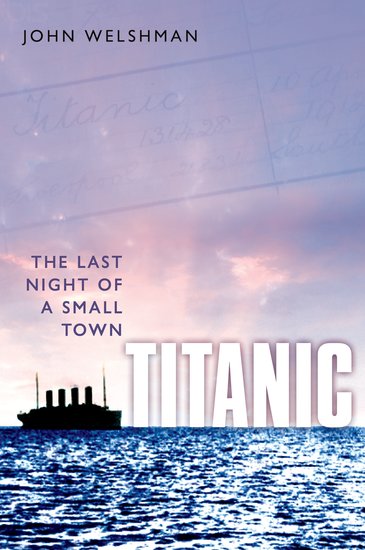By John Welshman
It was Walter Lord in A Night to Remember (1955) who described the sinking of the Titanic as “the last night of a small town.” Titanic: The Last Night of a Small Town, draws on Lord’s metaphor by focusing on the stories of just 12 people, chosen as a representative cross-section of passengers and crew.
The Titanic includes the famous and the forgotten; passengers from First, Second, and Third Class; women as well as men; children and adults; crew members and passengers; and people not only from Britain and the United States, but from South Africa, Finland, and the Lebanon. Those on board build a portrait of society from the bottom up. See the disaster through their eyes with personal narratives as a way into the wider social context of the period: social class; migration; gender; poverty; wealth; place; language; nationality.
What were the earlier histories of these people, their hopes and anxieties? Which of them survived, and why, and who perished? What happened to them in the years after 1912? And what can we learn from their accounts? On the centenary of the sinking, I tried to reconstruct the individual histories of twelve of the inhabitants of that small town.
Lawrence Beesley (35) is an English science teacher. One of his pupils at Dulwich College, London, was a boy called Raymond Chandler. Beesley’s wife Cissy has recently died of tuberculosis, and he has decided to visit his brother in Toronto. He is travelling Second Class.
Harold Bride (22) is the Assistant Wireless Operator. He had been born in London in 1890, and had qualified in June 1911. His sending and receiving rate of 20 words a minute had been deemed to be ‘very good’.
Edith Brown (15) is travelling with her parents Elizabeth and Thomas in Second Class. She had been born in South Africa, and the family is emigrating to live in Seattle in the United States.
Frank Goldsmith (9) is travelling with his parents Emily and Frank. The family is from Strood in Kent, England, and they are travelling Third Class. Like the Browns, they are emigrating to the United States, but in their case to Detroit.
Colonel Archibald Gracie (53) is a wealthy American amateur military historian. He has just finished writing a book about his father, and has been on holiday in Europe. He is travelling First Class.
Eva Hart (7) is travelling in Second Class with her parents Benjamin and Esther. The family are from Seven Kings, east of London. They are also emigrating, but in their case to Winnipeg, in Canada. Eva is carrying a large doll that her father bought for her in Gamages Department Store in Holborn, London.
Elin Hakkarainen (24) is a domestic servant, originally from Helsinki in Finland, but who had been working in the United States. Her husband Pekka had also been working there, in a steel mill, in Monessen, Pennsylvania. The couple got married in Helsinki in January, and are looking forward to their new lives in the United States.
Violet Jessop (24) is a Stewardess, working in First Class. Violet was born in Buenos Aires, Argentina, in 1887. Her best friend is another Stewardess, Elizabeth Leather.
Herbert ‘Lights’ Lightoller (38) is the Second Officer. He was born in Chorley, Lancashire, in 1874. The crew have been reshuffled, and he has just been demoted from First Officer to Second.
Arthur Rostron (43) is not on the Titanic, but is Captain of the Carpathia liner. He was born in Bolton in 1869, and has had a long career on various ships. On 11 April 1912, the Carpathia leaves New York and is heading in the opposite direction to the Titanic, for Fiume on the Adriatic coast.
Elizabeth Shutes (40) is a governess, travelling in First Class with the Graham family. Her charge Margaret Graham is 19, and also in the party is Margaret’s mother, Edith. Elizabeth was born in 1871, in Newburgh, New York.
Hanna Touma (27) is travelling in Third Class with her children Maria and Georges. The family is from a village called Tibnin in the Middle East and are travelling to be reunited with Hanna’s husband, Darwis. He is already working in the United States, in a town called Dowagiac, Michigan.
John Welshman is Senior Lecturer in the Department of History at Lancaster University. He is the author or editor of six books on twentieth-century British social history, including Titanic: The Last Night of a Small Town and Churchill’s Children: The Evacuee Experience in Wartime Britain. Read John Welshman’s previous blog posts “Fellowes and the Titanic” and “One Voyage, Two Thousand Stories.”
Subscribe to the OUPblog via email or RSS.
Subscribe to only history articles on the OUPblog via email or RSS.
View more about this book on the ![]()
![]()




Curious if the “Eva Hart” & family, from London, might have been related to Moss Hart. Moss was a very famous Broadway playright, director. His immediate family were from London, His biography makes no menion of a Titanic connection but perhaps it’s more than coincidence.